Community Health and Disease Prevention
VerifiedAdded on 2022/12/26
|14
|3276
|36
AI Summary
This article discusses the field of community health and disease prevention, focusing on health promotion strategies and the impact of obesity on communities. It explores the importance of community engagement and discusses various models and approaches to health promotion.
Contribute Materials
Your contribution can guide someone’s learning journey. Share your
documents today.
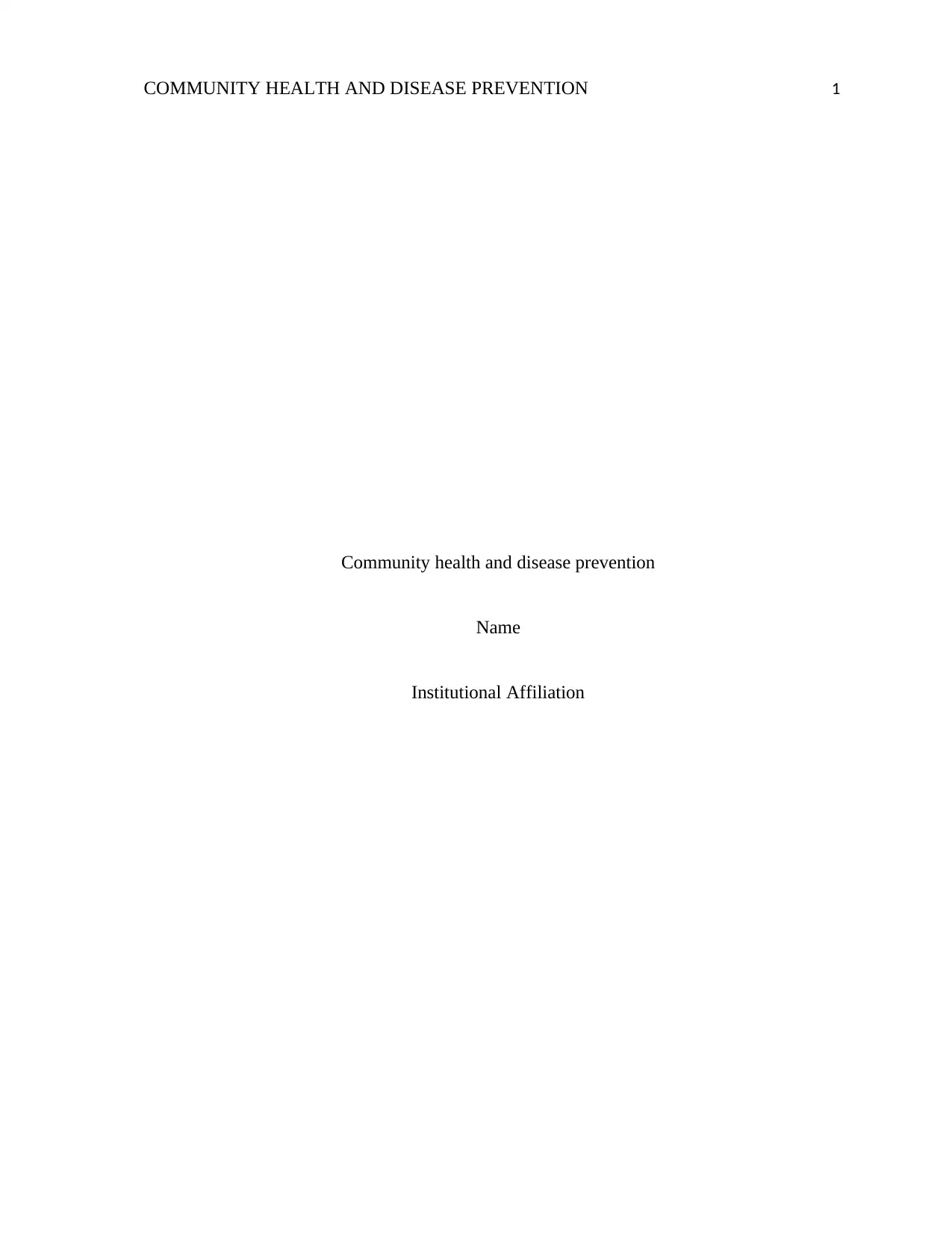
COMMUNITY HEALTH AND DISEASE PREVENTION 1
Community health and disease prevention
Name
Institutional Affiliation
Community health and disease prevention
Name
Institutional Affiliation
Secure Best Marks with AI Grader
Need help grading? Try our AI Grader for instant feedback on your assignments.

COMMUNITY HEALTH AND DISEASE PREVENTION 2
Introduction
Community health is a field of study which majorly focuses on protection, maintenance, and
healthcare impartments among population groups and communities by examining the health
characteristics over time (Reisner et al.2015). It can be majorly achieved by health promotion
which involves the empowering the community in order to give them control over their health.
This can be achieved through various ways including health literacy efforts and multi-sectional
actions which improves healthy behavior, this considers the activities in people's lives with are
believed to be contributing to the causes and spread of the diseases. It involves the population
dietary behaviors, sociocultural, environmental conditions, demographic factors and economic
factors that are considered key to influencing the populations' healthcare ( Murdaugh, Parsons &
Pender 2018). However, disease prevention is different from health promotion as its focus aims
at suppressing the development and the seriousness of chronic diseases and other forms of illness
(Piepoli et al., 2016). Health promotion and disease control are the crucial determinants of health
standards, as they influence decisions made by individuals towards positive health behavior. Like
decisions concerning poor eating habits, lack physical exercise and tobacco use and other eating
behaviors which would otherwise contribute to chronic diseases if not controlled positively.
Obesity best described as an excessive accumulation of body fat which poses a health risk to
individuals. It is diagnosed when the body mass index BMI is 30 or higher. The measurement of
the body mass index is calculated by the division of one’s weight in kilograms with the height in
meters. The disorder occurs when one consumes more calories compared to calories which are
burned in the body, this arises from poor diet and eating habit among the affected persons.
Introduction
Community health is a field of study which majorly focuses on protection, maintenance, and
healthcare impartments among population groups and communities by examining the health
characteristics over time (Reisner et al.2015). It can be majorly achieved by health promotion
which involves the empowering the community in order to give them control over their health.
This can be achieved through various ways including health literacy efforts and multi-sectional
actions which improves healthy behavior, this considers the activities in people's lives with are
believed to be contributing to the causes and spread of the diseases. It involves the population
dietary behaviors, sociocultural, environmental conditions, demographic factors and economic
factors that are considered key to influencing the populations' healthcare ( Murdaugh, Parsons &
Pender 2018). However, disease prevention is different from health promotion as its focus aims
at suppressing the development and the seriousness of chronic diseases and other forms of illness
(Piepoli et al., 2016). Health promotion and disease control are the crucial determinants of health
standards, as they influence decisions made by individuals towards positive health behavior. Like
decisions concerning poor eating habits, lack physical exercise and tobacco use and other eating
behaviors which would otherwise contribute to chronic diseases if not controlled positively.
Obesity best described as an excessive accumulation of body fat which poses a health risk to
individuals. It is diagnosed when the body mass index BMI is 30 or higher. The measurement of
the body mass index is calculated by the division of one’s weight in kilograms with the height in
meters. The disorder occurs when one consumes more calories compared to calories which are
burned in the body, this arises from poor diet and eating habit among the affected persons.
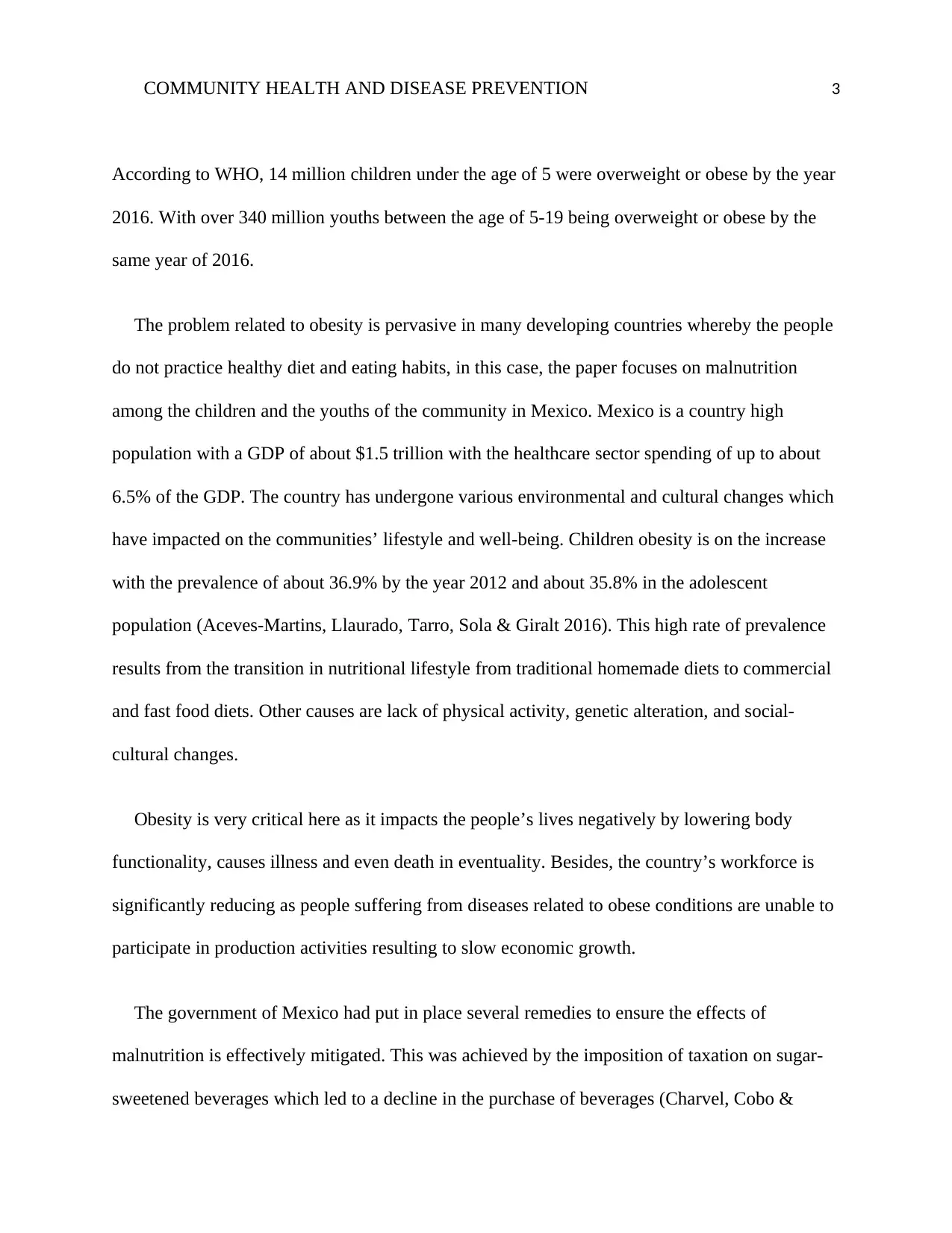
COMMUNITY HEALTH AND DISEASE PREVENTION 3
According to WHO, 14 million children under the age of 5 were overweight or obese by the year
2016. With over 340 million youths between the age of 5-19 being overweight or obese by the
same year of 2016.
The problem related to obesity is pervasive in many developing countries whereby the people
do not practice healthy diet and eating habits, in this case, the paper focuses on malnutrition
among the children and the youths of the community in Mexico. Mexico is a country high
population with a GDP of about $1.5 trillion with the healthcare sector spending of up to about
6.5% of the GDP. The country has undergone various environmental and cultural changes which
have impacted on the communities’ lifestyle and well-being. Children obesity is on the increase
with the prevalence of about 36.9% by the year 2012 and about 35.8% in the adolescent
population (Aceves-Martins, Llaurado, Tarro, Sola & Giralt 2016). This high rate of prevalence
results from the transition in nutritional lifestyle from traditional homemade diets to commercial
and fast food diets. Other causes are lack of physical activity, genetic alteration, and social-
cultural changes.
Obesity is very critical here as it impacts the people’s lives negatively by lowering body
functionality, causes illness and even death in eventuality. Besides, the country’s workforce is
significantly reducing as people suffering from diseases related to obese conditions are unable to
participate in production activities resulting to slow economic growth.
The government of Mexico had put in place several remedies to ensure the effects of
malnutrition is effectively mitigated. This was achieved by the imposition of taxation on sugar-
sweetened beverages which led to a decline in the purchase of beverages (Charvel, Cobo &
According to WHO, 14 million children under the age of 5 were overweight or obese by the year
2016. With over 340 million youths between the age of 5-19 being overweight or obese by the
same year of 2016.
The problem related to obesity is pervasive in many developing countries whereby the people
do not practice healthy diet and eating habits, in this case, the paper focuses on malnutrition
among the children and the youths of the community in Mexico. Mexico is a country high
population with a GDP of about $1.5 trillion with the healthcare sector spending of up to about
6.5% of the GDP. The country has undergone various environmental and cultural changes which
have impacted on the communities’ lifestyle and well-being. Children obesity is on the increase
with the prevalence of about 36.9% by the year 2012 and about 35.8% in the adolescent
population (Aceves-Martins, Llaurado, Tarro, Sola & Giralt 2016). This high rate of prevalence
results from the transition in nutritional lifestyle from traditional homemade diets to commercial
and fast food diets. Other causes are lack of physical activity, genetic alteration, and social-
cultural changes.
Obesity is very critical here as it impacts the people’s lives negatively by lowering body
functionality, causes illness and even death in eventuality. Besides, the country’s workforce is
significantly reducing as people suffering from diseases related to obese conditions are unable to
participate in production activities resulting to slow economic growth.
The government of Mexico had put in place several remedies to ensure the effects of
malnutrition is effectively mitigated. This was achieved by the imposition of taxation on sugar-
sweetened beverages which led to a decline in the purchase of beverages (Charvel, Cobo &
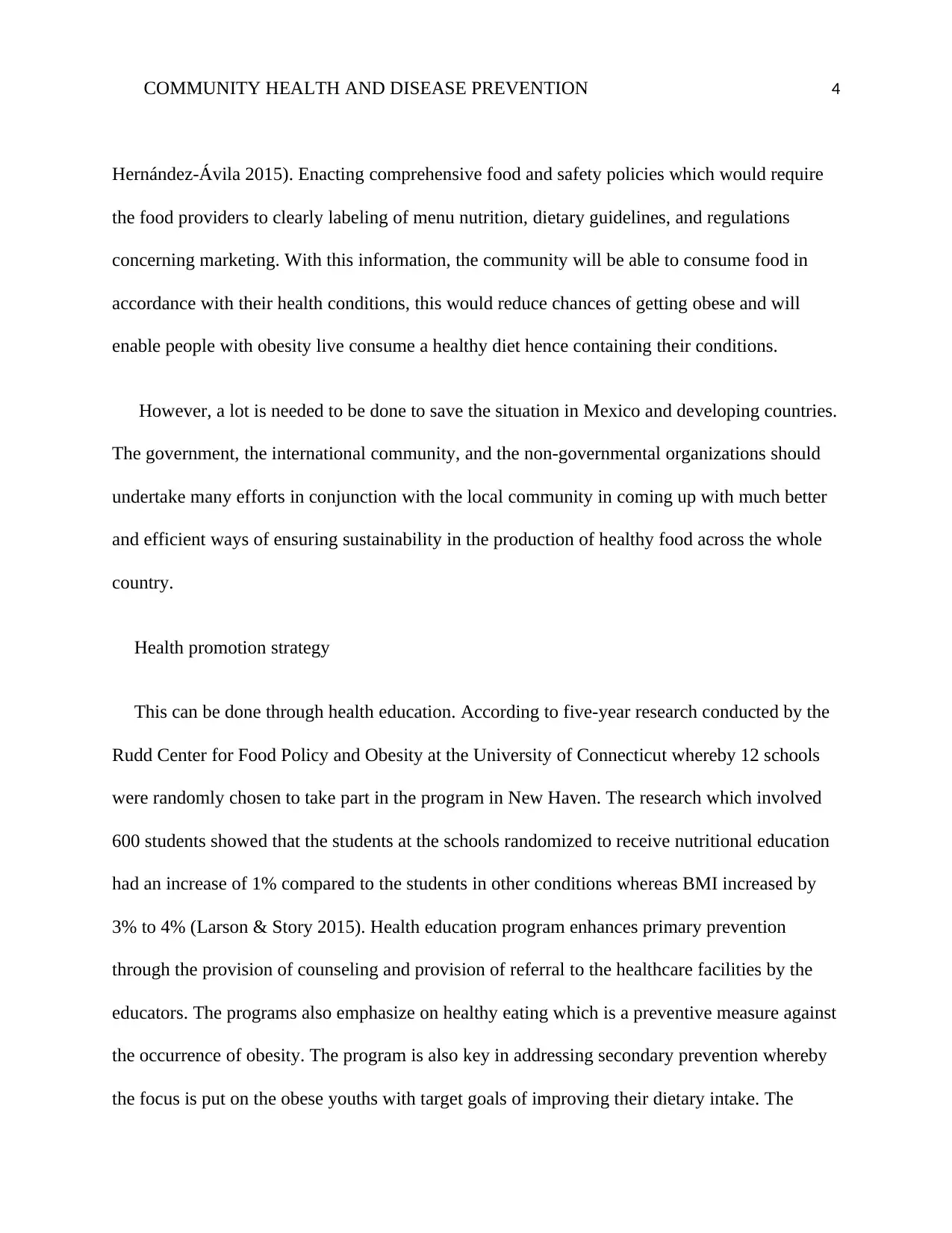
COMMUNITY HEALTH AND DISEASE PREVENTION 4
Hernández-Ávila 2015). Enacting comprehensive food and safety policies which would require
the food providers to clearly labeling of menu nutrition, dietary guidelines, and regulations
concerning marketing. With this information, the community will be able to consume food in
accordance with their health conditions, this would reduce chances of getting obese and will
enable people with obesity live consume a healthy diet hence containing their conditions.
However, a lot is needed to be done to save the situation in Mexico and developing countries.
The government, the international community, and the non-governmental organizations should
undertake many efforts in conjunction with the local community in coming up with much better
and efficient ways of ensuring sustainability in the production of healthy food across the whole
country.
Health promotion strategy
This can be done through health education. According to five-year research conducted by the
Rudd Center for Food Policy and Obesity at the University of Connecticut whereby 12 schools
were randomly chosen to take part in the program in New Haven. The research which involved
600 students showed that the students at the schools randomized to receive nutritional education
had an increase of 1% compared to the students in other conditions whereas BMI increased by
3% to 4% (Larson & Story 2015). Health education program enhances primary prevention
through the provision of counseling and provision of referral to the healthcare facilities by the
educators. The programs also emphasize on healthy eating which is a preventive measure against
the occurrence of obesity. The program is also key in addressing secondary prevention whereby
the focus is put on the obese youths with target goals of improving their dietary intake. The
Hernández-Ávila 2015). Enacting comprehensive food and safety policies which would require
the food providers to clearly labeling of menu nutrition, dietary guidelines, and regulations
concerning marketing. With this information, the community will be able to consume food in
accordance with their health conditions, this would reduce chances of getting obese and will
enable people with obesity live consume a healthy diet hence containing their conditions.
However, a lot is needed to be done to save the situation in Mexico and developing countries.
The government, the international community, and the non-governmental organizations should
undertake many efforts in conjunction with the local community in coming up with much better
and efficient ways of ensuring sustainability in the production of healthy food across the whole
country.
Health promotion strategy
This can be done through health education. According to five-year research conducted by the
Rudd Center for Food Policy and Obesity at the University of Connecticut whereby 12 schools
were randomly chosen to take part in the program in New Haven. The research which involved
600 students showed that the students at the schools randomized to receive nutritional education
had an increase of 1% compared to the students in other conditions whereas BMI increased by
3% to 4% (Larson & Story 2015). Health education program enhances primary prevention
through the provision of counseling and provision of referral to the healthcare facilities by the
educators. The programs also emphasize on healthy eating which is a preventive measure against
the occurrence of obesity. The program is also key in addressing secondary prevention whereby
the focus is put on the obese youths with target goals of improving their dietary intake. The
Secure Best Marks with AI Grader
Need help grading? Try our AI Grader for instant feedback on your assignments.
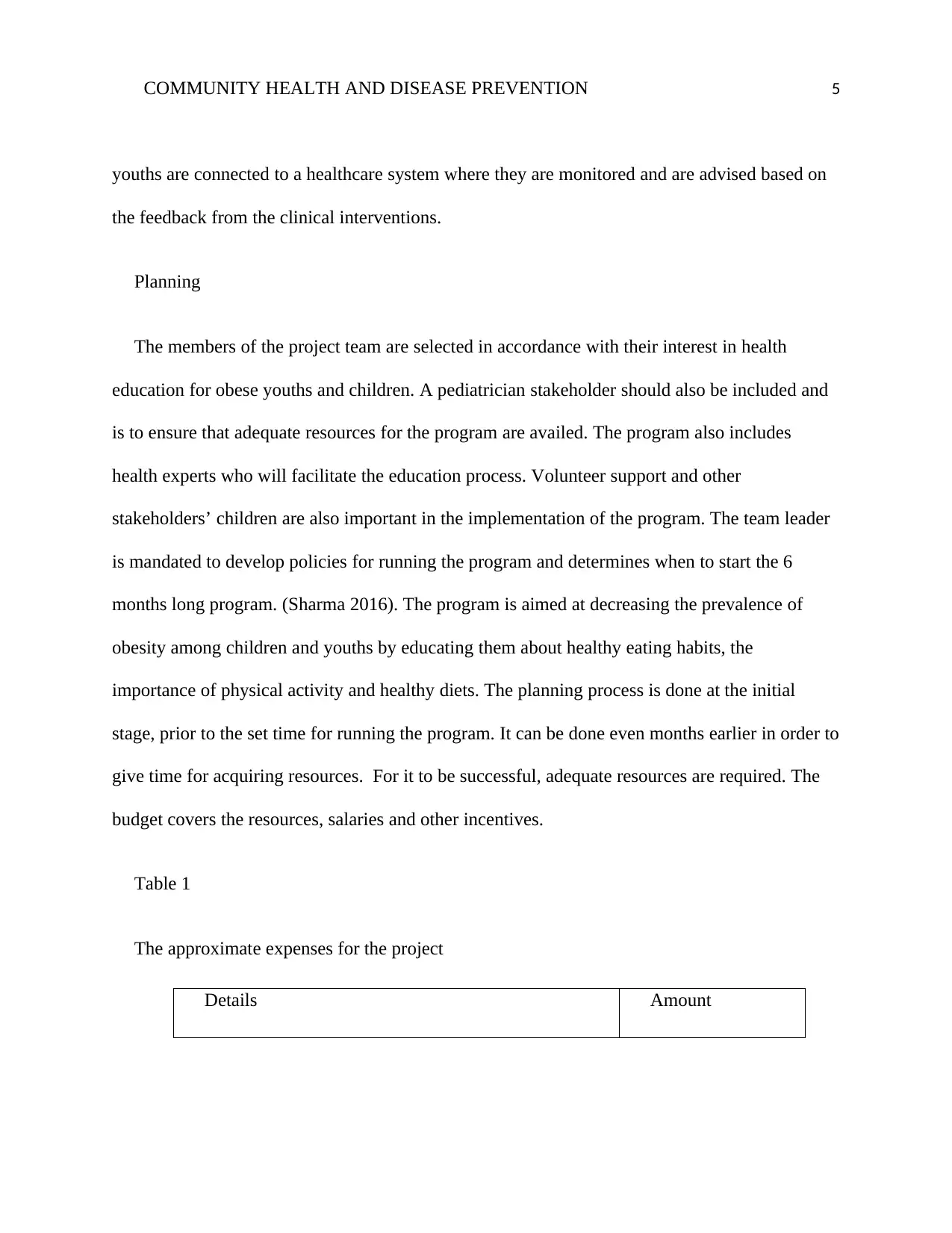
COMMUNITY HEALTH AND DISEASE PREVENTION 5
youths are connected to a healthcare system where they are monitored and are advised based on
the feedback from the clinical interventions.
Planning
The members of the project team are selected in accordance with their interest in health
education for obese youths and children. A pediatrician stakeholder should also be included and
is to ensure that adequate resources for the program are availed. The program also includes
health experts who will facilitate the education process. Volunteer support and other
stakeholders’ children are also important in the implementation of the program. The team leader
is mandated to develop policies for running the program and determines when to start the 6
months long program. (Sharma 2016). The program is aimed at decreasing the prevalence of
obesity among children and youths by educating them about healthy eating habits, the
importance of physical activity and healthy diets. The planning process is done at the initial
stage, prior to the set time for running the program. It can be done even months earlier in order to
give time for acquiring resources. For it to be successful, adequate resources are required. The
budget covers the resources, salaries and other incentives.
Table 1
The approximate expenses for the project
Details Amount
youths are connected to a healthcare system where they are monitored and are advised based on
the feedback from the clinical interventions.
Planning
The members of the project team are selected in accordance with their interest in health
education for obese youths and children. A pediatrician stakeholder should also be included and
is to ensure that adequate resources for the program are availed. The program also includes
health experts who will facilitate the education process. Volunteer support and other
stakeholders’ children are also important in the implementation of the program. The team leader
is mandated to develop policies for running the program and determines when to start the 6
months long program. (Sharma 2016). The program is aimed at decreasing the prevalence of
obesity among children and youths by educating them about healthy eating habits, the
importance of physical activity and healthy diets. The planning process is done at the initial
stage, prior to the set time for running the program. It can be done even months earlier in order to
give time for acquiring resources. For it to be successful, adequate resources are required. The
budget covers the resources, salaries and other incentives.
Table 1
The approximate expenses for the project
Details Amount
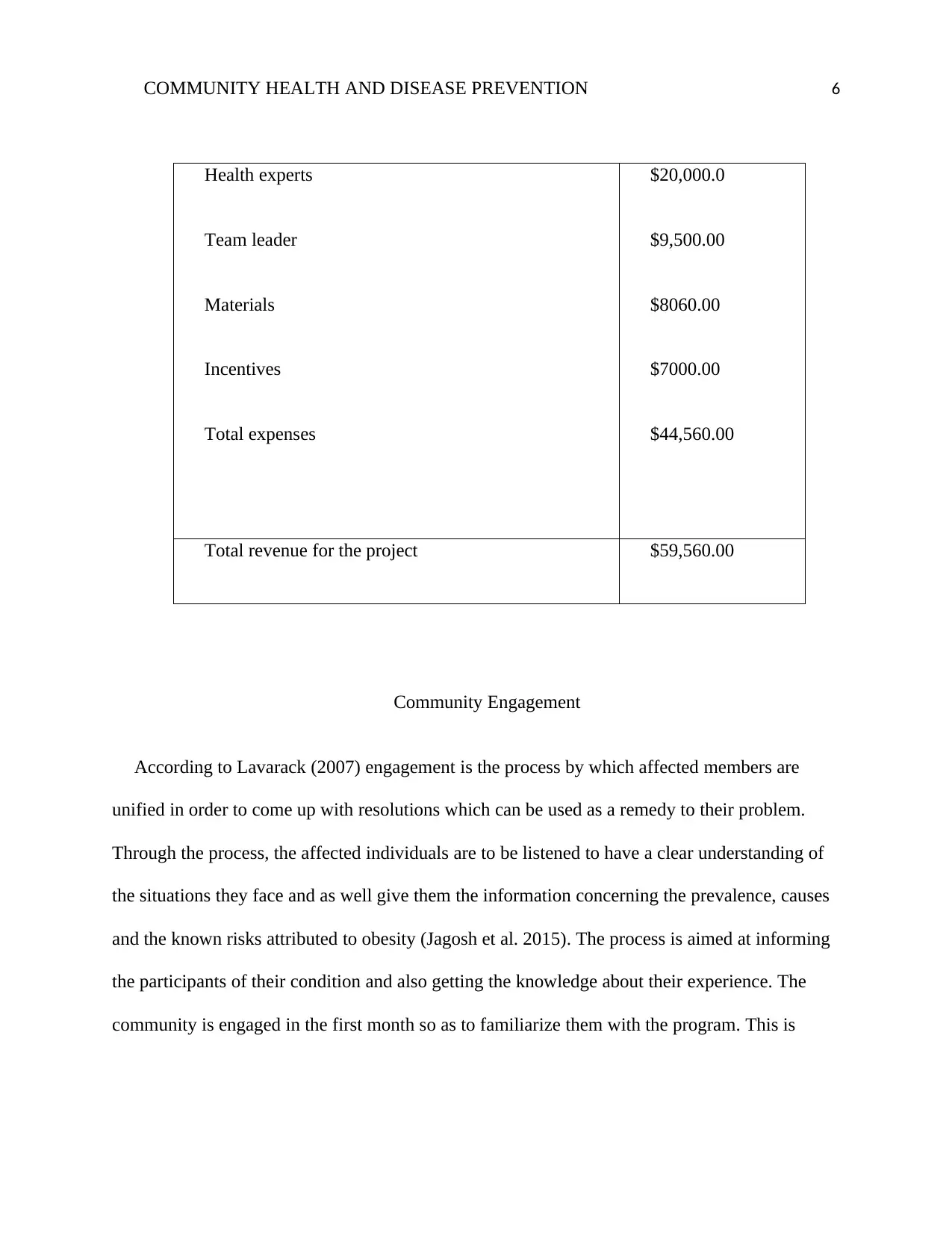
COMMUNITY HEALTH AND DISEASE PREVENTION 6
Health experts
Team leader
Materials
Incentives
Total expenses
$20,000.0
$9,500.00
$8060.00
$7000.00
$44,560.00
Total revenue for the project $59,560.00
Community Engagement
According to Lavarack (2007) engagement is the process by which affected members are
unified in order to come up with resolutions which can be used as a remedy to their problem.
Through the process, the affected individuals are to be listened to have a clear understanding of
the situations they face and as well give them the information concerning the prevalence, causes
and the known risks attributed to obesity (Jagosh et al. 2015). The process is aimed at informing
the participants of their condition and also getting the knowledge about their experience. The
community is engaged in the first month so as to familiarize them with the program. This is
Health experts
Team leader
Materials
Incentives
Total expenses
$20,000.0
$9,500.00
$8060.00
$7000.00
$44,560.00
Total revenue for the project $59,560.00
Community Engagement
According to Lavarack (2007) engagement is the process by which affected members are
unified in order to come up with resolutions which can be used as a remedy to their problem.
Through the process, the affected individuals are to be listened to have a clear understanding of
the situations they face and as well give them the information concerning the prevalence, causes
and the known risks attributed to obesity (Jagosh et al. 2015). The process is aimed at informing
the participants of their condition and also getting the knowledge about their experience. The
community is engaged in the first month so as to familiarize them with the program. This is
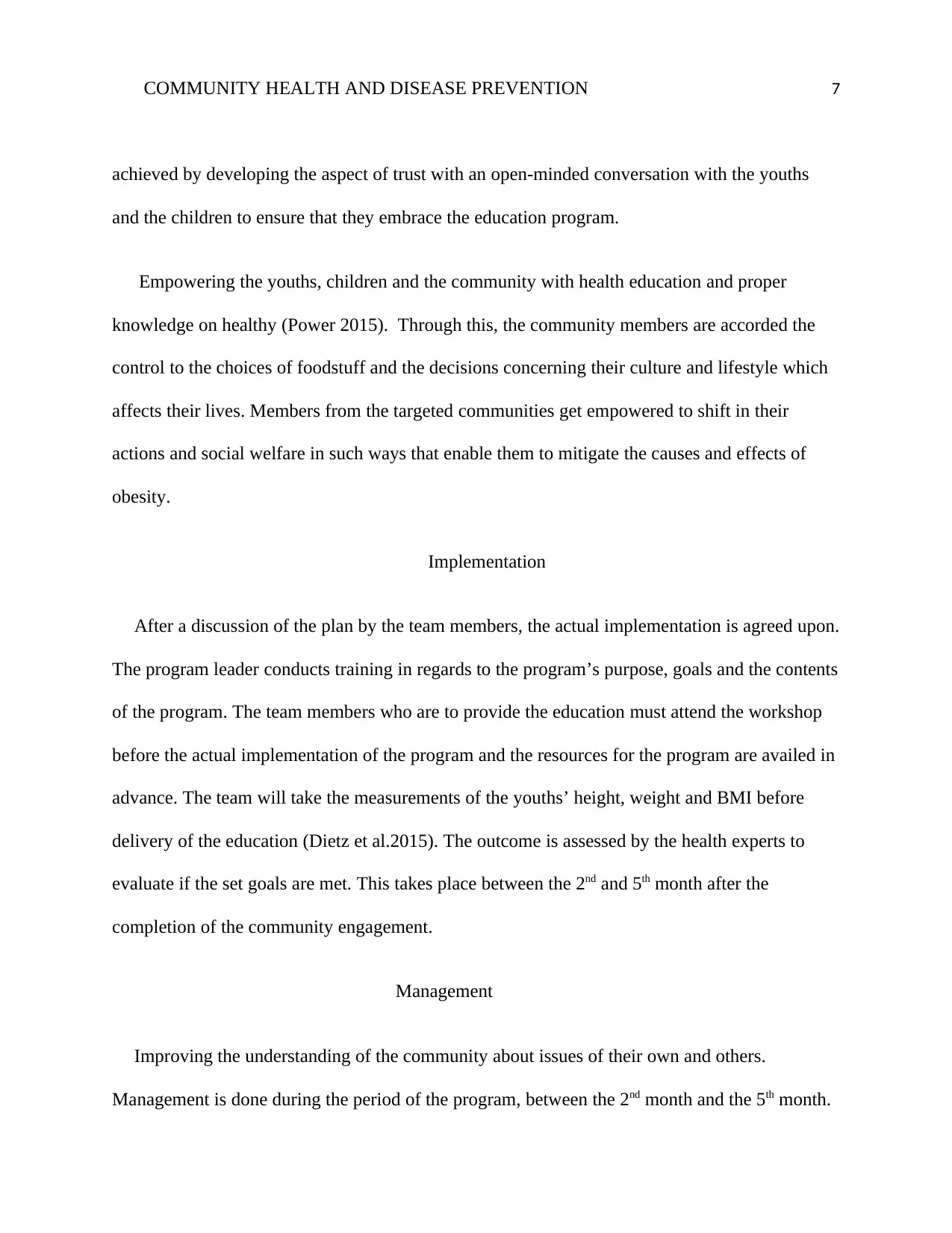
COMMUNITY HEALTH AND DISEASE PREVENTION 7
achieved by developing the aspect of trust with an open-minded conversation with the youths
and the children to ensure that they embrace the education program.
Empowering the youths, children and the community with health education and proper
knowledge on healthy (Power 2015). Through this, the community members are accorded the
control to the choices of foodstuff and the decisions concerning their culture and lifestyle which
affects their lives. Members from the targeted communities get empowered to shift in their
actions and social welfare in such ways that enable them to mitigate the causes and effects of
obesity.
Implementation
After a discussion of the plan by the team members, the actual implementation is agreed upon.
The program leader conducts training in regards to the program’s purpose, goals and the contents
of the program. The team members who are to provide the education must attend the workshop
before the actual implementation of the program and the resources for the program are availed in
advance. The team will take the measurements of the youths’ height, weight and BMI before
delivery of the education (Dietz et al.2015). The outcome is assessed by the health experts to
evaluate if the set goals are met. This takes place between the 2nd and 5th month after the
completion of the community engagement.
Management
Improving the understanding of the community about issues of their own and others.
Management is done during the period of the program, between the 2nd month and the 5th month.
achieved by developing the aspect of trust with an open-minded conversation with the youths
and the children to ensure that they embrace the education program.
Empowering the youths, children and the community with health education and proper
knowledge on healthy (Power 2015). Through this, the community members are accorded the
control to the choices of foodstuff and the decisions concerning their culture and lifestyle which
affects their lives. Members from the targeted communities get empowered to shift in their
actions and social welfare in such ways that enable them to mitigate the causes and effects of
obesity.
Implementation
After a discussion of the plan by the team members, the actual implementation is agreed upon.
The program leader conducts training in regards to the program’s purpose, goals and the contents
of the program. The team members who are to provide the education must attend the workshop
before the actual implementation of the program and the resources for the program are availed in
advance. The team will take the measurements of the youths’ height, weight and BMI before
delivery of the education (Dietz et al.2015). The outcome is assessed by the health experts to
evaluate if the set goals are met. This takes place between the 2nd and 5th month after the
completion of the community engagement.
Management
Improving the understanding of the community about issues of their own and others.
Management is done during the period of the program, between the 2nd month and the 5th month.
Paraphrase This Document
Need a fresh take? Get an instant paraphrase of this document with our AI Paraphraser
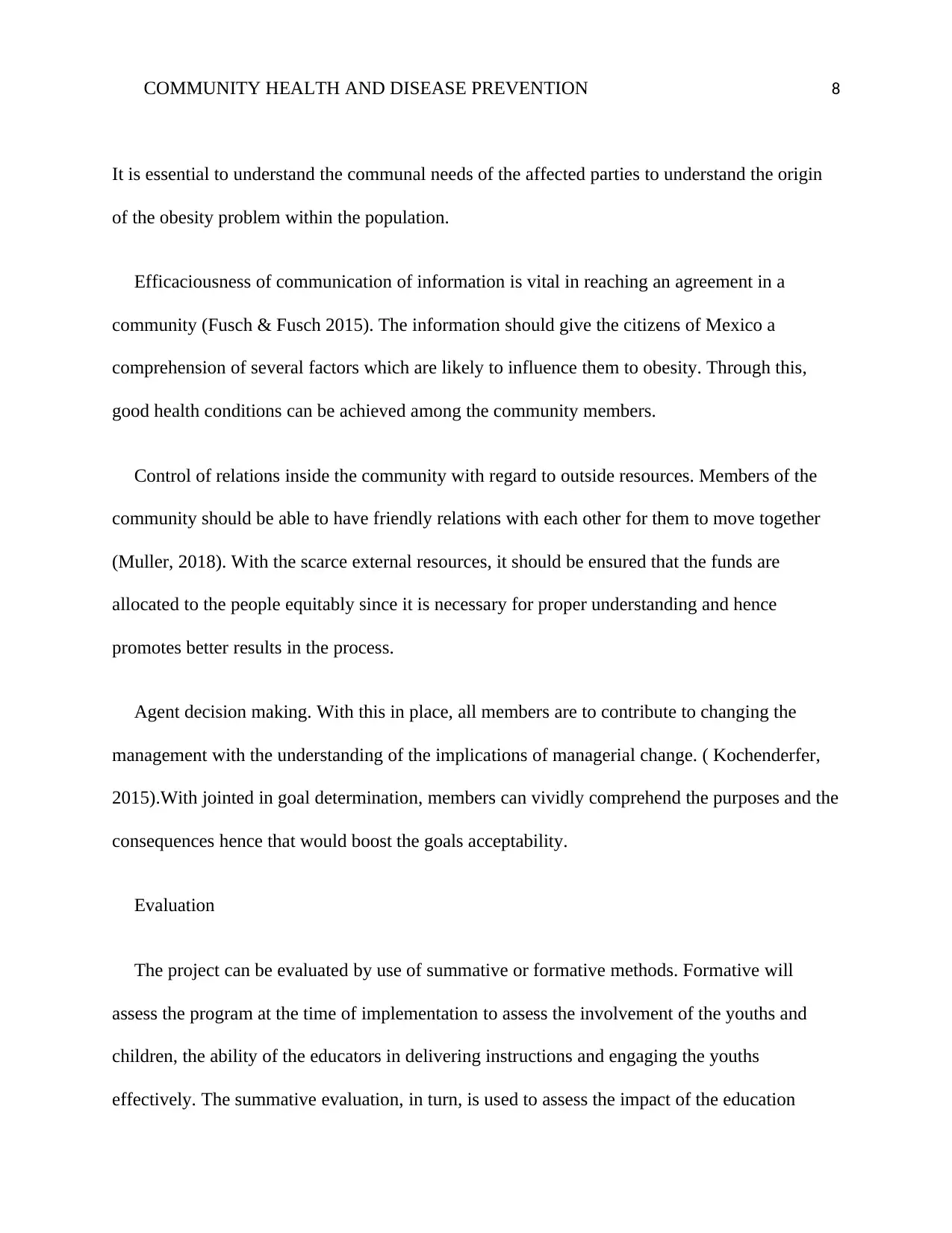
COMMUNITY HEALTH AND DISEASE PREVENTION 8
It is essential to understand the communal needs of the affected parties to understand the origin
of the obesity problem within the population.
Efficaciousness of communication of information is vital in reaching an agreement in a
community (Fusch & Fusch 2015). The information should give the citizens of Mexico a
comprehension of several factors which are likely to influence them to obesity. Through this,
good health conditions can be achieved among the community members.
Control of relations inside the community with regard to outside resources. Members of the
community should be able to have friendly relations with each other for them to move together
(Muller, 2018). With the scarce external resources, it should be ensured that the funds are
allocated to the people equitably since it is necessary for proper understanding and hence
promotes better results in the process.
Agent decision making. With this in place, all members are to contribute to changing the
management with the understanding of the implications of managerial change. ( Kochenderfer,
2015).With jointed in goal determination, members can vividly comprehend the purposes and the
consequences hence that would boost the goals acceptability.
Evaluation
The project can be evaluated by use of summative or formative methods. Formative will
assess the program at the time of implementation to assess the involvement of the youths and
children, the ability of the educators in delivering instructions and engaging the youths
effectively. The summative evaluation, in turn, is used to assess the impact of the education
It is essential to understand the communal needs of the affected parties to understand the origin
of the obesity problem within the population.
Efficaciousness of communication of information is vital in reaching an agreement in a
community (Fusch & Fusch 2015). The information should give the citizens of Mexico a
comprehension of several factors which are likely to influence them to obesity. Through this,
good health conditions can be achieved among the community members.
Control of relations inside the community with regard to outside resources. Members of the
community should be able to have friendly relations with each other for them to move together
(Muller, 2018). With the scarce external resources, it should be ensured that the funds are
allocated to the people equitably since it is necessary for proper understanding and hence
promotes better results in the process.
Agent decision making. With this in place, all members are to contribute to changing the
management with the understanding of the implications of managerial change. ( Kochenderfer,
2015).With jointed in goal determination, members can vividly comprehend the purposes and the
consequences hence that would boost the goals acceptability.
Evaluation
The project can be evaluated by use of summative or formative methods. Formative will
assess the program at the time of implementation to assess the involvement of the youths and
children, the ability of the educators in delivering instructions and engaging the youths
effectively. The summative evaluation, in turn, is used to assess the impact of the education
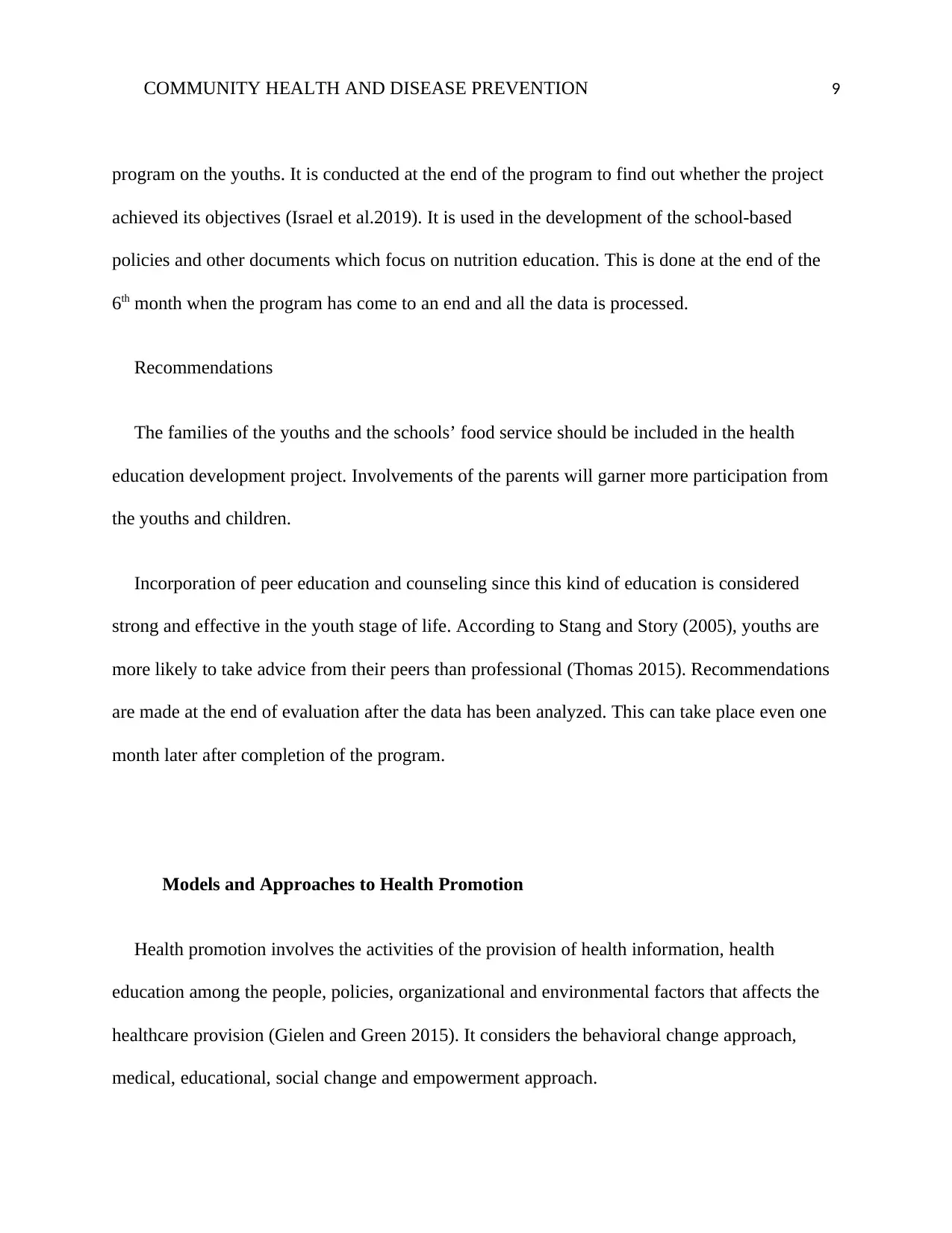
COMMUNITY HEALTH AND DISEASE PREVENTION 9
program on the youths. It is conducted at the end of the program to find out whether the project
achieved its objectives (Israel et al.2019). It is used in the development of the school-based
policies and other documents which focus on nutrition education. This is done at the end of the
6th month when the program has come to an end and all the data is processed.
Recommendations
The families of the youths and the schools’ food service should be included in the health
education development project. Involvements of the parents will garner more participation from
the youths and children.
Incorporation of peer education and counseling since this kind of education is considered
strong and effective in the youth stage of life. According to Stang and Story (2005), youths are
more likely to take advice from their peers than professional (Thomas 2015). Recommendations
are made at the end of evaluation after the data has been analyzed. This can take place even one
month later after completion of the program.
Models and Approaches to Health Promotion
Health promotion involves the activities of the provision of health information, health
education among the people, policies, organizational and environmental factors that affects the
healthcare provision (Gielen and Green 2015). It considers the behavioral change approach,
medical, educational, social change and empowerment approach.
program on the youths. It is conducted at the end of the program to find out whether the project
achieved its objectives (Israel et al.2019). It is used in the development of the school-based
policies and other documents which focus on nutrition education. This is done at the end of the
6th month when the program has come to an end and all the data is processed.
Recommendations
The families of the youths and the schools’ food service should be included in the health
education development project. Involvements of the parents will garner more participation from
the youths and children.
Incorporation of peer education and counseling since this kind of education is considered
strong and effective in the youth stage of life. According to Stang and Story (2005), youths are
more likely to take advice from their peers than professional (Thomas 2015). Recommendations
are made at the end of evaluation after the data has been analyzed. This can take place even one
month later after completion of the program.
Models and Approaches to Health Promotion
Health promotion involves the activities of the provision of health information, health
education among the people, policies, organizational and environmental factors that affects the
healthcare provision (Gielen and Green 2015). It considers the behavioral change approach,
medical, educational, social change and empowerment approach.
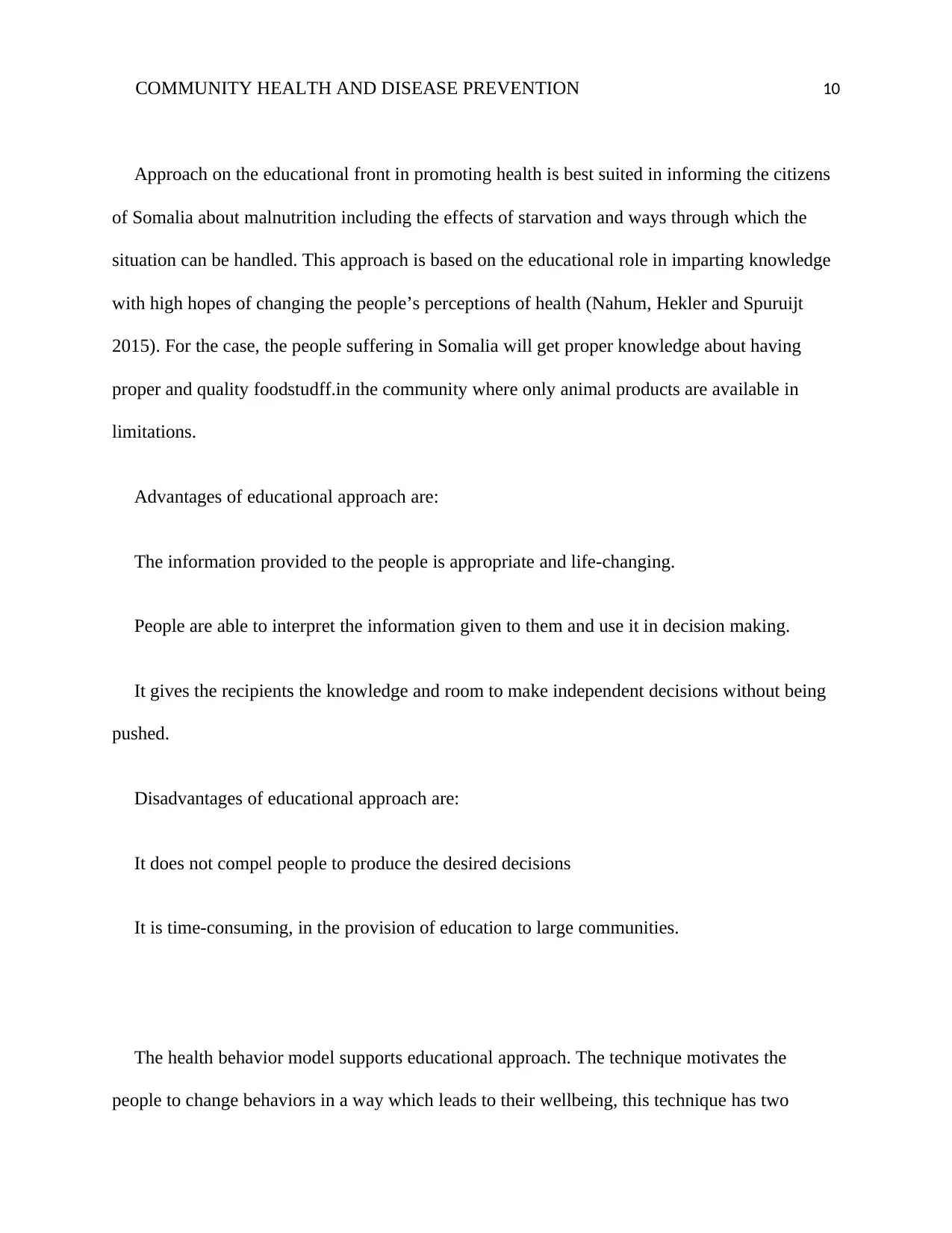
COMMUNITY HEALTH AND DISEASE PREVENTION 10
Approach on the educational front in promoting health is best suited in informing the citizens
of Somalia about malnutrition including the effects of starvation and ways through which the
situation can be handled. This approach is based on the educational role in imparting knowledge
with high hopes of changing the people’s perceptions of health (Nahum, Hekler and Spuruijt
2015). For the case, the people suffering in Somalia will get proper knowledge about having
proper and quality foodstudff.in the community where only animal products are available in
limitations.
Advantages of educational approach are:
The information provided to the people is appropriate and life-changing.
People are able to interpret the information given to them and use it in decision making.
It gives the recipients the knowledge and room to make independent decisions without being
pushed.
Disadvantages of educational approach are:
It does not compel people to produce the desired decisions
It is time-consuming, in the provision of education to large communities.
The health behavior model supports educational approach. The technique motivates the
people to change behaviors in a way which leads to their wellbeing, this technique has two
Approach on the educational front in promoting health is best suited in informing the citizens
of Somalia about malnutrition including the effects of starvation and ways through which the
situation can be handled. This approach is based on the educational role in imparting knowledge
with high hopes of changing the people’s perceptions of health (Nahum, Hekler and Spuruijt
2015). For the case, the people suffering in Somalia will get proper knowledge about having
proper and quality foodstudff.in the community where only animal products are available in
limitations.
Advantages of educational approach are:
The information provided to the people is appropriate and life-changing.
People are able to interpret the information given to them and use it in decision making.
It gives the recipients the knowledge and room to make independent decisions without being
pushed.
Disadvantages of educational approach are:
It does not compel people to produce the desired decisions
It is time-consuming, in the provision of education to large communities.
The health behavior model supports educational approach. The technique motivates the
people to change behaviors in a way which leads to their wellbeing, this technique has two
Secure Best Marks with AI Grader
Need help grading? Try our AI Grader for instant feedback on your assignments.
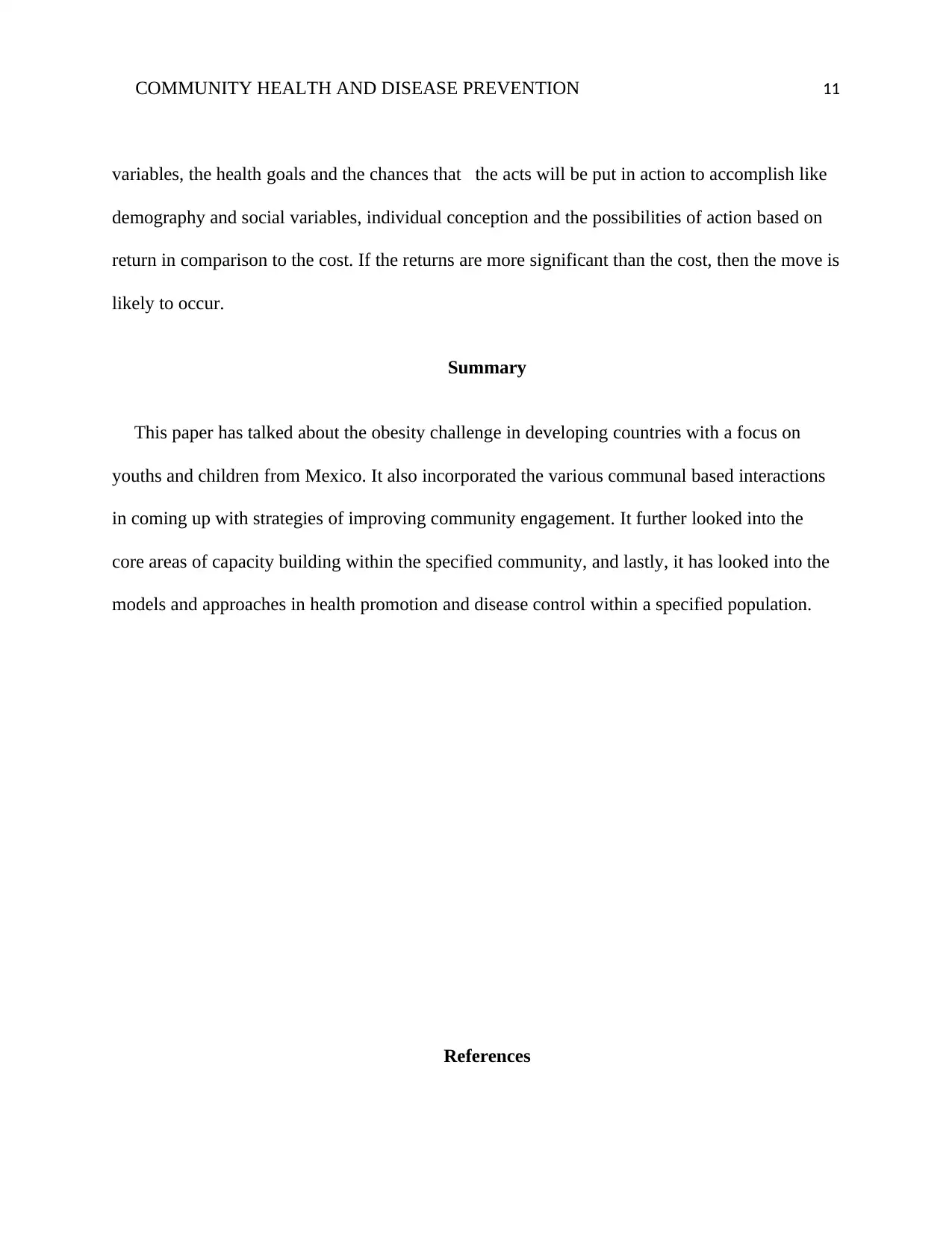
COMMUNITY HEALTH AND DISEASE PREVENTION 11
variables, the health goals and the chances that the acts will be put in action to accomplish like
demography and social variables, individual conception and the possibilities of action based on
return in comparison to the cost. If the returns are more significant than the cost, then the move is
likely to occur.
Summary
This paper has talked about the obesity challenge in developing countries with a focus on
youths and children from Mexico. It also incorporated the various communal based interactions
in coming up with strategies of improving community engagement. It further looked into the
core areas of capacity building within the specified community, and lastly, it has looked into the
models and approaches in health promotion and disease control within a specified population.
References
variables, the health goals and the chances that the acts will be put in action to accomplish like
demography and social variables, individual conception and the possibilities of action based on
return in comparison to the cost. If the returns are more significant than the cost, then the move is
likely to occur.
Summary
This paper has talked about the obesity challenge in developing countries with a focus on
youths and children from Mexico. It also incorporated the various communal based interactions
in coming up with strategies of improving community engagement. It further looked into the
core areas of capacity building within the specified community, and lastly, it has looked into the
models and approaches in health promotion and disease control within a specified population.
References
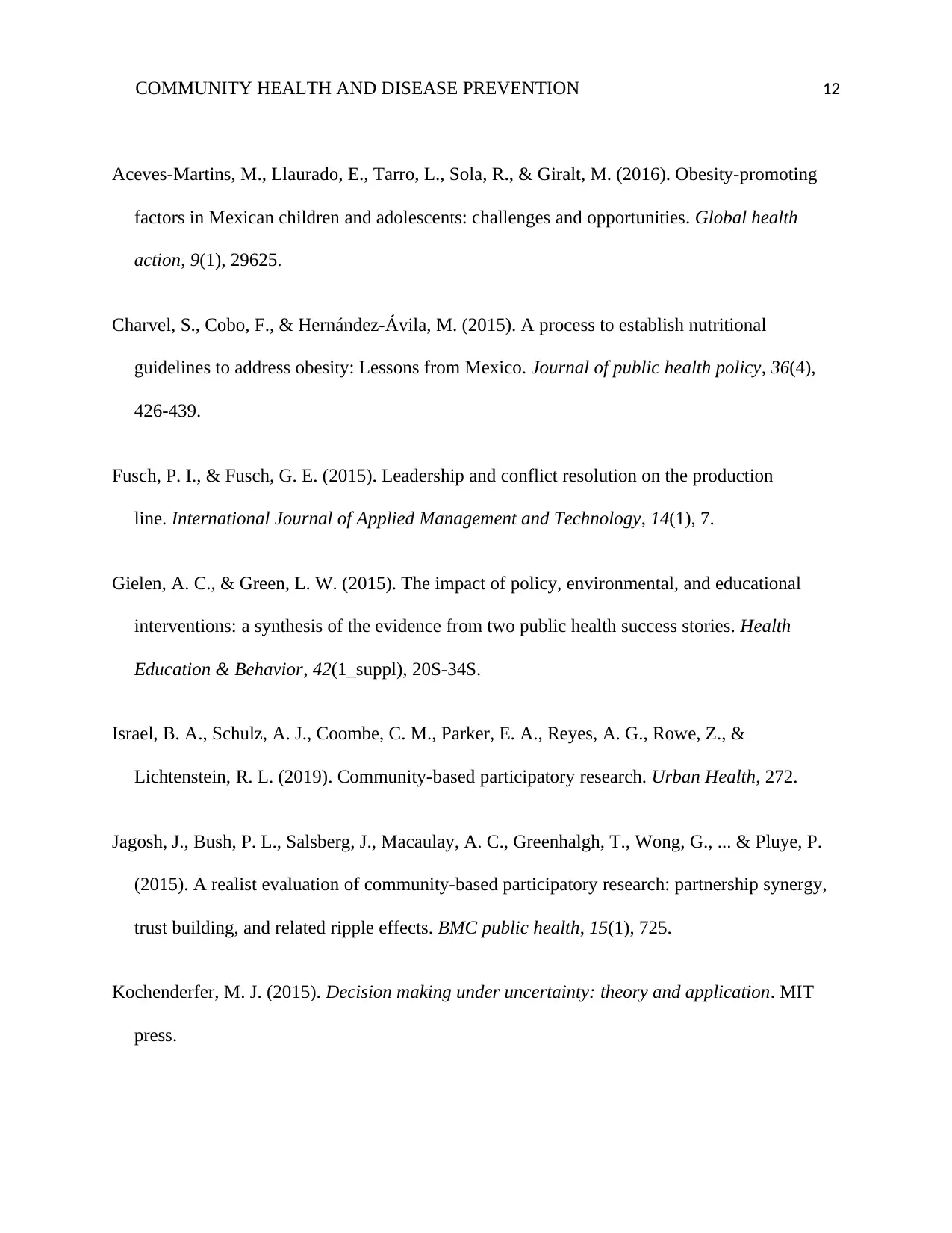
COMMUNITY HEALTH AND DISEASE PREVENTION 12
Aceves-Martins, M., Llaurado, E., Tarro, L., Sola, R., & Giralt, M. (2016). Obesity-promoting
factors in Mexican children and adolescents: challenges and opportunities. Global health
action, 9(1), 29625.
Charvel, S., Cobo, F., & Hernández-Ávila, M. (2015). A process to establish nutritional
guidelines to address obesity: Lessons from Mexico. Journal of public health policy, 36(4),
426-439.
Fusch, P. I., & Fusch, G. E. (2015). Leadership and conflict resolution on the production
line. International Journal of Applied Management and Technology, 14(1), 7.
Gielen, A. C., & Green, L. W. (2015). The impact of policy, environmental, and educational
interventions: a synthesis of the evidence from two public health success stories. Health
Education & Behavior, 42(1_suppl), 20S-34S.
Israel, B. A., Schulz, A. J., Coombe, C. M., Parker, E. A., Reyes, A. G., Rowe, Z., &
Lichtenstein, R. L. (2019). Community-based participatory research. Urban Health, 272.
Jagosh, J., Bush, P. L., Salsberg, J., Macaulay, A. C., Greenhalgh, T., Wong, G., ... & Pluye, P.
(2015). A realist evaluation of community-based participatory research: partnership synergy,
trust building, and related ripple effects. BMC public health, 15(1), 725.
Kochenderfer, M. J. (2015). Decision making under uncertainty: theory and application. MIT
press.
Aceves-Martins, M., Llaurado, E., Tarro, L., Sola, R., & Giralt, M. (2016). Obesity-promoting
factors in Mexican children and adolescents: challenges and opportunities. Global health
action, 9(1), 29625.
Charvel, S., Cobo, F., & Hernández-Ávila, M. (2015). A process to establish nutritional
guidelines to address obesity: Lessons from Mexico. Journal of public health policy, 36(4),
426-439.
Fusch, P. I., & Fusch, G. E. (2015). Leadership and conflict resolution on the production
line. International Journal of Applied Management and Technology, 14(1), 7.
Gielen, A. C., & Green, L. W. (2015). The impact of policy, environmental, and educational
interventions: a synthesis of the evidence from two public health success stories. Health
Education & Behavior, 42(1_suppl), 20S-34S.
Israel, B. A., Schulz, A. J., Coombe, C. M., Parker, E. A., Reyes, A. G., Rowe, Z., &
Lichtenstein, R. L. (2019). Community-based participatory research. Urban Health, 272.
Jagosh, J., Bush, P. L., Salsberg, J., Macaulay, A. C., Greenhalgh, T., Wong, G., ... & Pluye, P.
(2015). A realist evaluation of community-based participatory research: partnership synergy,
trust building, and related ripple effects. BMC public health, 15(1), 725.
Kochenderfer, M. J. (2015). Decision making under uncertainty: theory and application. MIT
press.
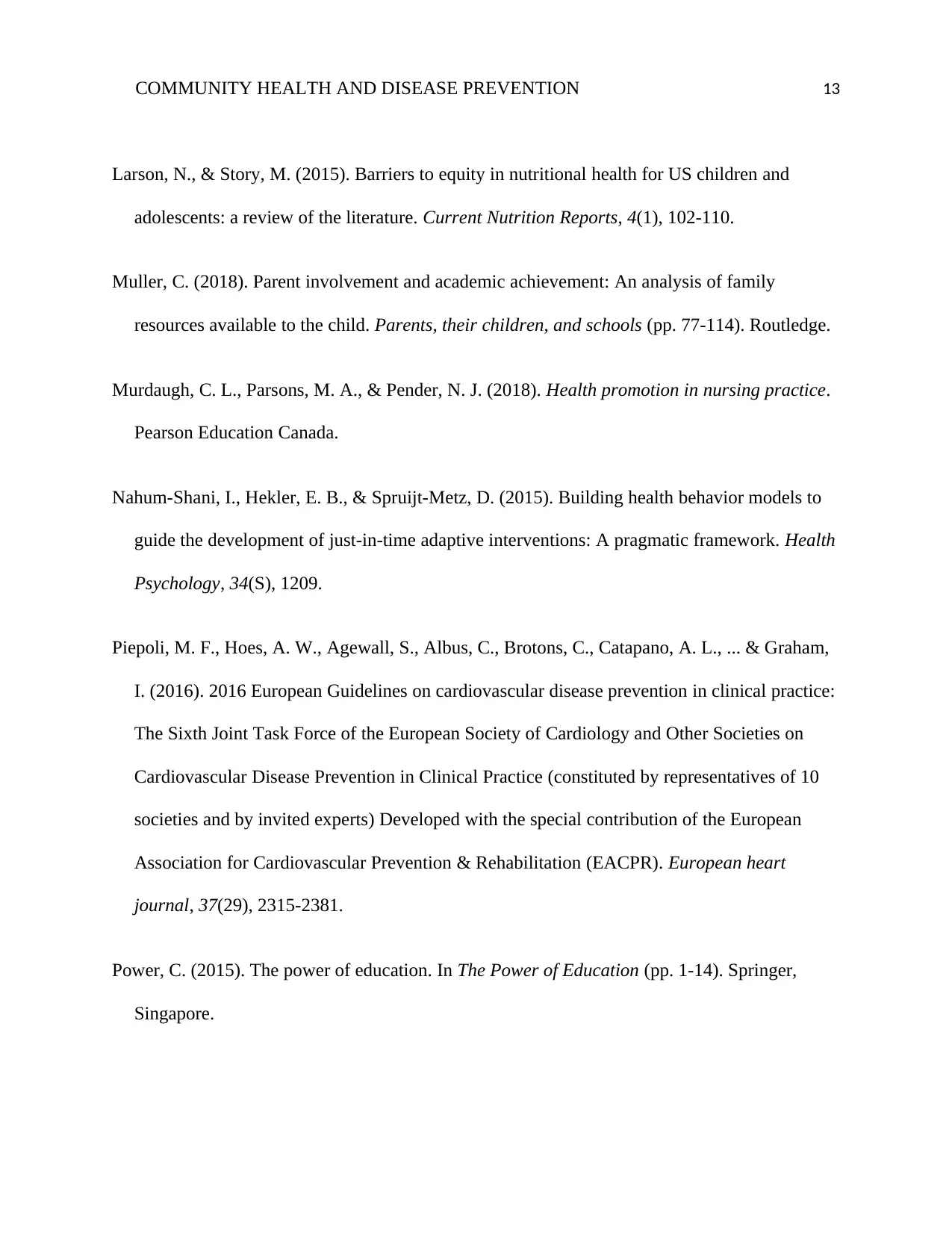
COMMUNITY HEALTH AND DISEASE PREVENTION 13
Larson, N., & Story, M. (2015). Barriers to equity in nutritional health for US children and
adolescents: a review of the literature. Current Nutrition Reports, 4(1), 102-110.
Muller, C. (2018). Parent involvement and academic achievement: An analysis of family
resources available to the child. Parents, their children, and schools (pp. 77-114). Routledge.
Murdaugh, C. L., Parsons, M. A., & Pender, N. J. (2018). Health promotion in nursing practice.
Pearson Education Canada.
Nahum-Shani, I., Hekler, E. B., & Spruijt-Metz, D. (2015). Building health behavior models to
guide the development of just-in-time adaptive interventions: A pragmatic framework. Health
Psychology, 34(S), 1209.
Piepoli, M. F., Hoes, A. W., Agewall, S., Albus, C., Brotons, C., Catapano, A. L., ... & Graham,
I. (2016). 2016 European Guidelines on cardiovascular disease prevention in clinical practice:
The Sixth Joint Task Force of the European Society of Cardiology and Other Societies on
Cardiovascular Disease Prevention in Clinical Practice (constituted by representatives of 10
societies and by invited experts) Developed with the special contribution of the European
Association for Cardiovascular Prevention & Rehabilitation (EACPR). European heart
journal, 37(29), 2315-2381.
Power, C. (2015). The power of education. In The Power of Education (pp. 1-14). Springer,
Singapore.
Larson, N., & Story, M. (2015). Barriers to equity in nutritional health for US children and
adolescents: a review of the literature. Current Nutrition Reports, 4(1), 102-110.
Muller, C. (2018). Parent involvement and academic achievement: An analysis of family
resources available to the child. Parents, their children, and schools (pp. 77-114). Routledge.
Murdaugh, C. L., Parsons, M. A., & Pender, N. J. (2018). Health promotion in nursing practice.
Pearson Education Canada.
Nahum-Shani, I., Hekler, E. B., & Spruijt-Metz, D. (2015). Building health behavior models to
guide the development of just-in-time adaptive interventions: A pragmatic framework. Health
Psychology, 34(S), 1209.
Piepoli, M. F., Hoes, A. W., Agewall, S., Albus, C., Brotons, C., Catapano, A. L., ... & Graham,
I. (2016). 2016 European Guidelines on cardiovascular disease prevention in clinical practice:
The Sixth Joint Task Force of the European Society of Cardiology and Other Societies on
Cardiovascular Disease Prevention in Clinical Practice (constituted by representatives of 10
societies and by invited experts) Developed with the special contribution of the European
Association for Cardiovascular Prevention & Rehabilitation (EACPR). European heart
journal, 37(29), 2315-2381.
Power, C. (2015). The power of education. In The Power of Education (pp. 1-14). Springer,
Singapore.
Paraphrase This Document
Need a fresh take? Get an instant paraphrase of this document with our AI Paraphraser

COMMUNITY HEALTH AND DISEASE PREVENTION 14
Reisner, S. L., Vetters, R., Leclerc, M., Zaslow, S., Wolfrum, S., Shumer, D., & Mimiaga, M. J.
(2015). The mental health of transgender youth in care at an adolescent urban community
health center: a matched retrospective cohort study. Journal of Adolescent Health, 56(3), 274-
279.
Sharma, M. (2016). Theoretical foundations of health education and health promotion. Jones &
Bartlett Publishers.
Dietz, W. H., Baur, L. A., Hall, K., Puhl, R. M., Taveras, E. M., Uauy, R., & Kopelman, P.
(2015). Management of obesity: improvement of health-care training and systems for
prevention and care. The Lancet, 385(9986), 2521-2533.
Reisner, S. L., Vetters, R., Leclerc, M., Zaslow, S., Wolfrum, S., Shumer, D., & Mimiaga, M. J.
(2015). The mental health of transgender youth in care at an adolescent urban community
health center: a matched retrospective cohort study. Journal of Adolescent Health, 56(3), 274-
279.
Sharma, M. (2016). Theoretical foundations of health education and health promotion. Jones &
Bartlett Publishers.
Dietz, W. H., Baur, L. A., Hall, K., Puhl, R. M., Taveras, E. M., Uauy, R., & Kopelman, P.
(2015). Management of obesity: improvement of health-care training and systems for
prevention and care. The Lancet, 385(9986), 2521-2533.
1 out of 14
Related Documents
Your All-in-One AI-Powered Toolkit for Academic Success.
+13062052269
info@desklib.com
Available 24*7 on WhatsApp / Email
![[object Object]](/_next/static/media/star-bottom.7253800d.svg)
Unlock your academic potential
© 2024 | Zucol Services PVT LTD | All rights reserved.




